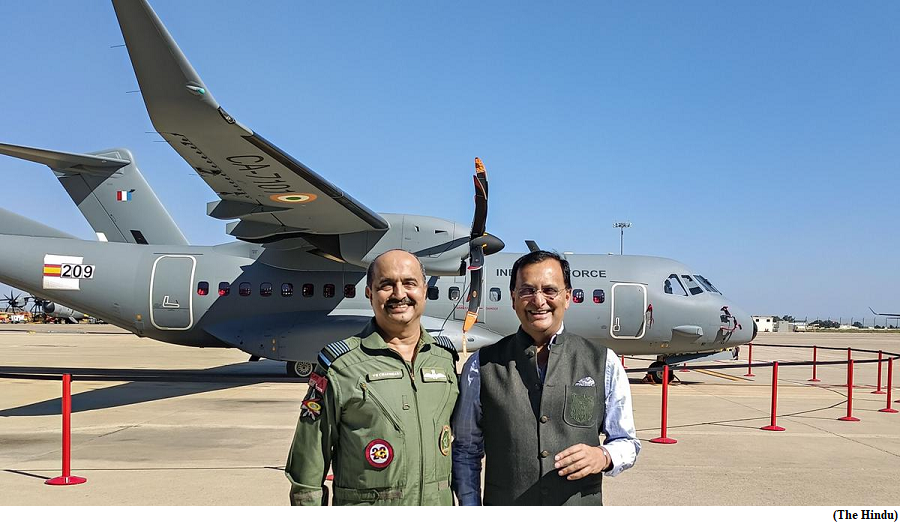Cabinet approves eCourts Phase III for 4 years (GS Paper 2, Judiciary)

Why in news?
- The Union Cabinet has approved the eCourts Project Phase III as a Central Sector Scheme spanning four years (2023 onwards) with financial outlay of Rs.7210 crore.
About eCourts Mission Mode Project:
- The eCourts Mission Mode Project is the prime mover for improving access to justice using technology.
- As part of the National eGovernance Plan, the e-Courts Project is under implementation since 2007 for ICT enablement of the Indian Judiciary the Phase II of which has concluded in 2023.
- Phase III of the e-Courts Project in India is rooted in philosophy of ‘access and inclusion’.
Phase-III:
- Taking the gains of Phase-I and Phase-II to the next level, the e-Courts Phase-III aims to usher in a regime of maximum ease of justice by moving towards digital, online and paperless courts through digitization of the entire court records including legacy records and by bringing in universalization of e-Filing/ e-Payments through saturation of all court complexes with e-Sewa Kendras.
- It will put in place intelligent smart systems enabling data-based decision making for judges and registries while scheduling or prioritizing cases.
- The main objective of the Phase-III is to create a unified technology platform for the judiciary, which will provide a seamless and paperless interface between the courts, the litigants and other stakeholders.
Implemented:
- The Centrally Sponsored Scheme of eCourts Phase III is being implemented under the joint partnership of Department of Justice, Ministry of Law & Justice, Government of India and eCommittee, Supreme Court of India, in a decentralized manner through the respective High Courts to develop a judicial system that would promote ease of justice by making the system more accessible, affordable, reliable, predictable, and transparent for all stakeholders.
The expected outcomes of the scheme are as follows:
- Citizens who do not have access to technology can access the judicial services from eSewa Kendras, thus bridging the digital divide.
- Digitization of court records lays the foundation for all other digital services in the project. It enables processes to become more environmental friendly by minimizing paper-based filings and reducing the physical movement of documents.
- Virtual participation in the court proceedings thus reducing costs associated with court proceedings, such as travel expenses for witnesses, judges, and other stakeholders.
- Payment of court fees, fines and penalties from anywhere, anytime.
- Expansion of eFiling for reducing the time and effort required to file documents. Thereby minimizing human errors as documents are automatically checked and also prevent further creation of paper based records.
- Use of latest technologies like Al and its subsets Machine Learning (ML), Optical Character Recognition (OCR), Natural Language Processing (NLP) to provide a smoother user experience by building a "smart" ecosystem. Registries will have less data entry and minimal file scrutiny facilitating better decision-making and policy planning. It envisages smart scheduling, intelligent system that enables data-based decision making for judges and registries, allows for greater predictability and optimisation of the capacity of judges and lawyers.
- Expansion of virtual courts beyond the adjudication of traffic violation cases, thereby eliminating the presence of litigant or lawyer in the court.
- Enhanced accuracy and transparency in court proceedings
- Emphasis on automated delivery of court summons by further expanding the NSTEP (National Serving and Tracking of Electronic Processes), hence drastically reducing the delays in trials.
- Use of emerging technologies in court processes will make them more efficient and effective, hence contributing significantly towards the reduction of pendency cases.
Analysing the Global Stocktake Report
(GS Paper 3, Environment)
Why in news?
- Ahead of the just concluded G-20 summit, the United Nations climate secretariat made public a ‘synthesis report’ on the results of three meetings held so far to discuss progress achieved by countries in achieving the goals of the Paris Agreement of 2015.

Why is it called the ‘global stocktake’ report?
- The synthesis report ties into a larger exercise called the ‘global stocktake,’ that is expected to take place once in five years.
- In 2015, when countries committed in Paris to keep global temperatures from rising beyond 2 degrees Celsius by the end of the century and “as far as possible” below 1.5 degrees Celsius, they also agreed to periodically review, or take stock of efforts, made by individual countries in containing greenhouse gases and transitioning their fossil-fuel dependent energy systems to renewable sources.
- The first report is expected to significantly influence discussions in November when country representatives converge in Dubai for the 28th edition of the UN climate Conference of Parties (COP) in November.
- While countries have laid out their Nationally Determined Contributions (NDC), they are expected to increase their ambitions every five years.
What does the report say?
- It lays out 17 ‘key findings’ that overall suggests that the world is not on track to achieve Paris Agreement targets, though there was still a “rapidly narrowing” window for countries to get their act together.
- The synthesis report isn’t a significant update on the UN synthesis report of 2022, released ahead of COP 27 in Egypt, where the NDCs of 166 countries were analysed to conclude that they were inadequate to meet Paris-agreed targets.
- The United Nations Emissions Gap Report, also released in 2022, reported that 23 billion tonnes of CO2 were required to be cut to keep emissions in line with Paris agreements, whereas current pledges by countries even if fully implemented would only cut 2-3 billion tonnes, leaving an emissions gap of around 20 billion tonnes.
What are the ‘key findings’?
- These 17 headline statements say that the Paris Agreement has galvanised countries into setting goals and signalling the urgency of the climate crisis.
- Governments need to support ways to transition their economies away from fossil fuel businesses and that states and communities must strengthen efforts. While rapid change could be “disruptive,” countries should work on ensuring that the economic transition be equitable and inclusive.
- It stated that much more ambition was needed to reduce global greenhouse gas emissions by 43% by 2030 and further by 60% in 2035 and reach net zero CO2 emissions by 2050 globally.
- Renewable energy has to be scaled up and all ‘unabated fossil fuels’ (for example, coal plants without carbon capture and storage mechanisms) were to be rapidly eliminated.
- Deforestation and land-degradation have to be halted and reversed and agricultural practices critical to reducing emissions and conserving and enhancing carbon sinks have to be encouraged.
- Transparent reporting on adaptation could facilitate and enhance understanding, implementation and international cooperation.
- Averting, minimising and addressing ‘loss and damage,’ requires urgent action across climate and development policies to manage risks comprehensively and provide support to impacted communities.
- Support for adaptation and funding arrangements for averting, minimising and addressing loss and damage, from the impact of climate change, needed to be rapidly scaled up from expanded and innovative sources. Financial flows needed to be made consistent with climate-resilient development to meet urgent and increasing needs.
- Access to climate finance in developing countries needed to be enhanced. It was “essential” to unlock and redeploy trillions of dollars to meet global investment needs, including by rapidly shifting finance flows globally to support a pathway towards low GHG emissions and climate-resilient development.
IAF chief takes delivery of first C-295 transport aircraft in Spain
(GS Paper 3, Defence)
Why in news?
- Recently, India got its first C-295 transport aircraft providing a crucial boost to the nation’s defence capabilities.
- Indian Air Force (IAF) chief Air Chief Marshal VR Chaudhari was in Spain’s Seville city to receive the first plane from aircraft manufacturer Airbus’ facility.

Background:
- In 2021, the defence ministry signed a Rs 21,935 crore deal with Airbus and Space SA, Spain, to procure 56 C-295MW transport aircraft to replace IAF’s Avro fleet.
- The 56 C-295 aircraft will replace the ageing Avro aircraft.
Joint venture:
- Under the contract, 16 aircraft will come in fly-away condition from Seville while 40 will be manufactured by Airbus jointly with Tata Advanced Systems Ltd. (TASL).
- Work is under way to set up the final assembly line (FAL) at Vadodara in Gujarat and the first aircraft manufactured in India will be delivered in September 2026.
How it will be manufactured in India?
- The first made-in-India aircraft will be delivered in 2026, while the rest 39 by 2031.
- This is the first time that a military aircraft will be produced by a private Indian company.
- TASL, which set up a factory in Telangana’s Hyderabad in 2022, will produce major components such as fuselage at this facility. All parts produced in Hyderabad will be shifted to the factory in Gujarat’s Vadodara in 2023.
- The FAL (Final Assembly Line) in Vadodara will be ready by mid-2024 and start production by November 2024.
- Six IAF pilots have already received training at the Airbus facility in Seville. In May, the first C295 developed for India successfully took its maiden flight from the Spanish city.
Features of C-295 aircraft:
- Airbus’ C-295 aircraft can carry up to nine tonnes of cargo. The military plane, with the capacity to transport 71 troops, has a cruising speed of 260 knots or around 481 kilometres per hour.
- The C295 is powered by two Pratt & Whitney Canada PW127G turboprop engines that provide excellent manoeuvrability, outstanding hot-and-high performance, with fuel consumption for a very long endurance of up to 13 hours aloft.
- It has a ramp door in the rear for para-dropping of troops and cargo. In case of a medical evacuation, the aircraft can accommodate 24 stretchers and seven medical attendants.
- The aircraft acquired by India will be equipped with indigenous radar warning receivers and missile approach warning systems developed by Bharat Electronics Limited (BEL). The Bharat Dynamics Limited (BDL) will provide a countermeasure dispensing system for the military planes, reported Indian Express.
How C-295 aircraft will benefit India?
- This deal is a crucial push for the Centre’s Make-in-India initiative, making the IAF the largest operator of the C-295 aircraft.
- The project will strengthen India’s aerospace ecosystem, wherein several MSMEs spread across the country will produce components of the aircraft. This will reportedly generate 15,000 high-skilled jobs and 10,000 indirect jobs in the next decade.
- It is also expected to reduce import dependency by enhancing domestic aviation manufacturing.
- Amid potential threats from China and Pakistan, the multi-role tactical airlifter will play a significant role in keeping India’s defences strong.




